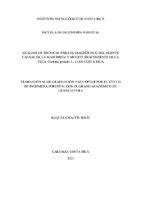Mostrar el registro sencillo del ítem
Análisis de técnicas para el diagnóstico del agente causal de la marchitez y muerte descendente de la teca (Tectona grandis L. f.) en Costa Rica
| dc.contributor.advisor | Méndez-Álvarez, Dawa | es |
| dc.contributor.author | Chacón-Solís, Raquel | |
| dc.date.accessioned | 2021-04-08T20:19:51Z | |
| dc.date.available | 2021-04-08T20:19:51Z | |
| dc.date.issued | 2021 | |
| dc.identifier.uri | https://hdl.handle.net/2238/12407 | |
| dc.description | Proyecto de Graduación (Licenciatura en Ingeniería Forestal) Instituto Tecnológico de Costa Rica, Escuela de Ingeniería Forestal, 2021 | es |
| dc.description.abstract | Tectona grandis es una de las especies forestales de mayor importancia y de las maderas más valiosas a nivel mundial. Sin embargo, enfermedades como la marchitez y muerte descendente pueden afectar significativamente la productividad de las plantaciones de la especie. Existen diversas hipótesis sobre la causa de la enfermedad, algunos científicos argumentan que se debe a malas condiciones de sitio y otros autores atribuyen el desarrollo de esta enfermedad a organismos fúngicos como el Ceratocystis fimbriata. Para diagnosticar la enfermedad, se realizó la corta de árboles en las zonas de Pococí y Abangares de Costa Rica. A los árboles se les extrajo de dos a tres galletas a diferentes alturas, se tomaron fragmentos de estas y se evaluaron métodos de aislamiento como el sándwich de zanahoria, cámara de humedad en agar agua y siembras directas en medio de cultivo. Además, con los hongos Ceratocystis fimbriata y Scytalidium lignícola aislados e identificados a partir de técnicas morfológicas y moleculares, se realizó la inoculación de tres genotipos, bajo condiciones de invernadero, para estudiar sobre la patogenicidad de estos hongos. Como resultados, se encontró que algunos de los métodos de aislamiento no fueron efectivos, debido a que no hubo crecimiento de patógenos, otros métodos fueron contaminados por diversos hongos y tuvieron crecimiento de bacterias. Por otra parte, en las evaluaciones del ensayo de patogenicidad se observaron plantas con síntomas como rebrotes y cancros. Y al realizar los análisis estadísticos se encontró un genotipo más susceptible al efecto causado por la inoculación, así como también un genotipo con mayor desempeño. Por otra parte, se pudo evidenciar que el hongo Ceratocystis fimbriata es patogénico y podría representar un riesgo para las plantas de teca. | es |
| dc.description.abstract | Tectona grandis is one of the most important forest species and the most valuable woods worldwide. However, diseases such as wilt and teak dieback can significantly affect the productivity of plantations of the species. There are various hypotheses about the cause of the disease, some scientists argue that it is due to poor site conditions and other authors attribute the development of this disease to fungal organisms such as Ceratocystis fimbriata. To diagnose the disease, trees were cut in the Pococí and Abangares areas of Costa Rica. Around two to three cross, sections were extracted from the trees at different heights, fragments of these were taken and some isolation methods such as carrot sandwich, humidity chamber in water agar and direct sowings in culture medium were evaluated. In addition, with the fungi Ceratocystis fimbriata and Scytalidium lignícola isolated e identified from morphological and molecular techniques, three genotypes were inoculated under greenhouse conditions, to learn about the pathogenicity of these fungi. As a result, it was found that some of those isolation methods were not effective, because there was no pathogens, growth; other methods were contaminated by various fungi and had bacteria growth. On the other hand, in the evaluations of the pathogenicity test, plants with symptoms such as sprouts and cankers were observed. In addition, when performing the statistical analyzes, a genotype more susceptible to the effect caused by inoculation was found, as well as a genotype with a higher performance. On the other hand, it was possible to show that the Ceratocystis fimbriata fungus is pathogenic and could represent a risk for teak plants. | es |
| dc.language.iso | spa | es |
| dc.publisher | Instituto Tecnológico de Costa Rica | es |
| dc.subject | Análisis de técnicas | es |
| dc.subject | Métodos de aislamiento | es |
| dc.subject | Inoculación | es |
| dc.subject | Genotipos | es |
| dc.subject | Hongos | es |
| dc.subject | Marchitez | es |
| dc.subject | Tectona grandis L. f. | es |
| dc.subject | Teca | es |
| dc.subject | Fungi | es |
| dc.subject | Isolation methods | es |
| dc.subject | Genotypes | es |
| dc.subject | Inoculation | es |
| dc.subject | Research Subject Categories::FORESTRY, AGRICULTURAL SCIENCES and LANDSCAPE PLANNING | es |
| dc.title | Análisis de técnicas para el diagnóstico del agente causal de la marchitez y muerte descendente de la teca (Tectona grandis L. f.) en Costa Rica | es |
| dc.type | licentiateThesis | es |


